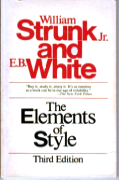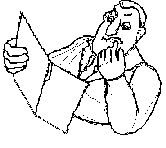

| Book of the Month | ||
 |
The Elements of Style |  |
Publisher: MacMillan Publishing
Author: W. Strunk and E.White
$6.95
ISBN 0-02-418230-3
The first edition of this book was published almost a century ago. The most recent edition was published four months ago. This fact alone should tell us that 'this persistent little book' (as the Boston Globe Newspaper describes it) is an essential reference book for anyone doing literary composition. Here we look at perhaps the most popular version of the book - the third edition - which was updated and enlarged by one of Prof. Strunk's students. Nevertheless even the 'expanded' edition is just eighty-five pages in length. One reason for this is because ofthe style of Prof. Strunk himself, whose rule 'omit unnecessary words' has been followed rigorously through this book. As the author says, keeping to the point is important because 'Language is communication, so clarity is essential to language'.
The book starts by introducing the reader to Prof. Strunk and his ideas. Then it proceeds to lay down the 'rules' of style. These are generally given as clear instructions, with good examples. For example 'It's a wise dog that scratches its own fleas' neatly shows when to use the apostrophe with 'its'. There are five chapters to the book, each of which contains about a dozen rules. The exceptions are chapters three and four. Chapter three deals with 'matters of form'; by which the author means, basically, how to write without seeming to be an idiot. Tips include avoiding unnecessary exclamation marks and hyphens and not using what are today called scare quotes (where words are unnecessarily picked out by quotation marks - like 'this'!). The next chapter deals with words that were often misused, such as 'anticipate' for 'expect' and which continue to be misused in the same way generations later. The final chapter is the only chapter which suggests that it is possible to break some of the rules in the previous chapters. Here the author admits that exactly what makes a particular piece of writing great is something of a mystery. However, while it is hard to explain what makes great writing, it is easy to identify and avoid the mistakes that make bad writing.
One of the good things about this book is that the authors follow their own rules. The text is clear, and once the reader becomes accustomed to the style, the examples are easy to follow.(For instance, when an example is given, there are two columns, with the correct versions on the right, the errors on the left.) There are no cartoons or other illustrations. One of the most important sections of the book comes at the end with advice to anyone preparing an essay or longer piece of writing. This points out that all writers have their own style. Concentrate on writing clearly and naturally and the style will come. Some essays are painful to read just because the writer has tried to force a 'literary' style, and overloaded the text with adjectives, similes and obscure words. Another important point is that any piece of written text is all the better for being re-read and revised. As the book explains, if great authors such as Faulkner and Hemingway had to do this, you should too.
Who is this book for? Almost anyone who writes in English will find this book useful. Advanced students who need to impress teachers and examiners with their written work will find that this book helps a great deal. Likewise university students should read this book before submitting essays. In an age when tutors have to struggle with so many poorly-written texts, a well-written piece will almost certainly get higher marks. However, not only students need good English - anyone who writes a letter to a bank manager, newspaper or government office will be taken more seriously if the letter is clear and well written.
Verdict: A timeless guide
Assessment 8/10